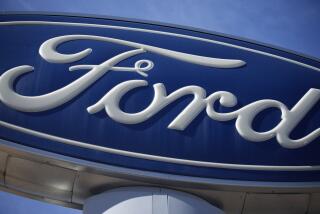GM seizes chance for fresh start
General Motors Corp.’s historic bankruptcy promises to turn more than $50 billion from taxpayers into a fresh start, allowing the struggling giant to again become an engine for the U.S. economy.
Freed from its most crushing financial obligations, GM hopes to rediscover profit in the century-old profession of building and selling autos.
But with the government poised to own 60% of GM, there was increased criticism Monday that President Obama had committed far too many taxpayer dollars, most of which may never get repaid, to a company lacking an answer to its most profound problem: how to get more car buyers to choose its cars and trucks.
GM executives plan to twist the firm’s substantial woes to its advantage, using the government-backed restructuring to rework its balance sheet: shedding dealers and vehicle brands, eliminating employees and plants, selling overseas units and learning to live with a smaller market share.
The big question is whether that formula adds up to a return to profitability -- or simply delays the company’s eventual collapse into insolvency.
GM will lack the heft to vie for the crown of the world’s largest auto company. It may not even remain the biggest automaker headquartered in the U.S., where it once accounted for more than half of all cars sold. Rival Ford Motor Co. may slide into that spot while GM struggles to regain its financial footing.
“GM will be trimmed down in almost every respect,” said Michael Robinet, a vice president of consulting firm CSM Worldwide. “And they’re not using scissors. They’re using a hatchet.”
Bankruptcy will leave lost jobs, diminished benefits, depleted investor portfolios and sacrificed dealerships in its wake. And because GM is effectively playing with the house’s money, the automaker is bringing the entire nation along for the ride.
It also will test the president’s political mettle. Obama came under attack from Republicans, who dubbed the company “Government Motors,” and even some Democrats for taking such a big stake in a company whose global market share is sliding.
“We are acting as reluctant shareholders because that is the only way to help GM succeed,” Obama said in a national address.
Despite marking the end of an era in the story of American industry and a low point for the storied automaker, GM executives characterized the bankruptcy filing as a once-in-a-lifetime chance to start anew.
“This is a remarkable opportunity for us,” GM Chief Executive Fritz Henderson said during a news conference at New York’s General Motors Building, where it now occupies only parts of two floors. “This allows us to permanently address problems that we have not been able to address before today.”
Critics of the plan worry that for every change GM’s restructuring promises to engender, it carries as many risks and leaves many questions unanswered. Most strikingly, some said, is that it doesn’t address how GM -- as well as Chrysler, which is also in Bankruptcy Court -- will convince Americans that its cars are worthy of the prices commanded by automakers such as Toyota Motor Corp.
“None of this is going to fix the lack of willingness among Americans to pay more for these cars,” said Susan Helper, an economist at Case Western Reserve University. “Much more important than a whiz-bang balance sheet turnaround is for GM to effect fundamental change.”
GM will sell or discontinue four of the brands it sells in the U.S. -- Pontiac, Hummer, Saturn and Saab. Pruning these marques, which accounted for 17% of the 2.9 million cars and light trucks GM sold in the U.S. last year, would leave the automaker with Chevrolet, Cadillac, Buick and GMC to stock its North American showrooms.
Among the new vehicles the automaker hopes will get the new GM off to a strong start are the redesigned Buick LaCrosse sedan; the SRX crossover and CTS sport wagon from Cadillac; the GMC Terrain and Chevy Equinox crossovers; the Chevy Cruze, GM’s new global subcompact; and the reintroduction of the classic Chevy Camaro muscle car.
The Chevy Volt, an extended-range gas-electric hybrid, may not be the game-changer GM hopes. Expected to list for $40,000 when it hits the market next year, the Volt may be too pricey for many buyers looking to save on gas costs -- a conclusion reached by Obama’s auto task force.
The company is in talks with Toyota about the future of their Bay Area joint venture, GM’s last manufacturing facility in California. Henderson said GM wouldn’t be making any more vehicles in the Fremont plant once the Pontiac brand is jettisoned. He said no decision had been made on whether GM would have an interest in the plant going forward.
GM’s blue-collar workforce in the U.S. will shrink to 38,000 by 2011. That would be down from about 61,000 in 2008 and a peak of 400,000 in 1985. GM’s dealer ranks are already being slashed, with a goal of downsizing its roster of more than 6,000 dealerships to about 3,600.
“Those of us who have been in the business couldn’t imagine this day happening,” said Don Signer, a Buick and Cadillac dealer in Newark, Calif., informed by GM last month that it was ending his franchise agreement after three decades. “It’s an American icon.”
There is little doubt that the automaker that emerges from Bankruptcy Court in as little as two to three months will be dramatically different.
Obama said his administration took the majority stake to protect its latest investment in GM, $30.1 billion to get the company through bankruptcy.
The remaining 40% of GM’s stock will be split among the government of Canada, which is putting up $9.5 billion in financing, and the United Auto Workers union and holders of $27 billion in GM bonds, who have agreed to forgive their debts.
Obama vowed that GM would be run by a private board of directors. He said the U.S. government would not be involved in day-to-day decisions, such as opening new plants or launching new vehicles. GM executives said the administration had indicated it planned to begin unloading its holdings after stock in the new company starts trading next year.
Some analysts have carped that the government could meddle in product decisions to push policy goals on fuel economy and emissions standards, or even favor GM when deciding what cars to buy for government fleets.
“It’s a very strange predicament,” said former U.S. Labor Secretary Robert Reich. “Is the goal to preserve and protect automobile jobs or is it to create a new, lean-and-mean, slimmed-down and debt-free GM?”
Even Democrats criticized restructuring plans that will further brutalize the nation’s workers. “There is a huge amount of pain associated with today’s announcements by General Motors,” Sen. Carl Levin (D-Mich.) said.
For now, GM’s fate will lie in the hands of Judge Robert Gerber of the U.S. Bankruptcy Court for the Southern District of New York. A standing-room-only crowd spilled out of the Manhattan court to watch the first day of events in GM’s case, in which Gerber approved motions to allow GM to continue operations while restructuring, including motions to pay employees and honor warrantees.
“We have to keep our eye on the ball, which is to save the business, to save as many jobs as possible,” Gerber said.
It is in the same court -- under the eyes of a different judge -- where Chrysler filed for bankruptcy protection just over a month ago, also at the urging of the administration. On Sunday night, the judge overseeing that case approved a sale of Chrysler’s assets into a new company, opening the door to a merger with Italian automaker Fiat and a fast exit from bankruptcy.
GM and the administration hope the GM filing will also be brief, although they both acknowledge that the automaker’s far larger size and complexity will draw out the process.
“Time is of the essence,” said Harvey Miller, GM’s lead bankruptcy attorney.
GM will rely on a sale of its desirable assets into a new company that will shed $57 billion of GM’s $74 billion in debt.
The GM that emerges, said Chief Financial Officer Ray Young, will be smaller, more agile and better poised to face the challenges of the complicated and distressed contemporary auto market. All of which, he argued, would be impossible without the government-backed bankruptcy.
“Why would a CFO be smiling when he’s filing for his company to go bankrupt?” Young asked. “I’ve never been so invigorated in my life. This is a once-in-a-lifetime opportunity to get our balance sheet healthy.”
--
martin.zimmerman@latimes.com
Times staff writers Jim Puzzanghera, Walter Hamilton and Nathan Olivarez-Giles and correspondent Ellen Lee contributed to this report.
--
BEGIN TEXT OF INFOBOX
What’s next for General Motors?
* A set of orders issued Monday by U.S. Bankruptcy Court Judge Robert Gerber, who is overseeing the General Motors case, will allow the company to pay employees, finance operating expenses and hire lawyers, accountants and other advisors to navigate Chapter 11. Such “first day” orders are a normal part of the bankruptcy process.
* The company will divide in two: “New GM” will be the continuing operation owned by the U.S. and Canadian governments, the United Auto Workers and the company’s current bondholders; “old GM” will include the parts of the company to be liquidated. Lawyers for General Motors asked Gerber to set a deadline of June 19 for objections to the proposed reorganization.
* The company split must be completed by July 10 or the U.S. Treasury will not finance the new company, GM lawyers said.
* Seven of the 12 GM board members will be replaced in consultation with the Obama administration.
----
General Motors’ top creditors in millions
Wilmington Trust... $22,760
United Auto Workers... 20,560
Deutsche Bank... 4,444
Electrical/Communications Union... 2,669
Bank of New York Mellon... 176
Starcom Mediavest Group ...122
Delphi... 111
Robert Bosch... 66
Lear...45
Renco Group...37
Source: Bloomberg News
----
Voices
‘It was coming, so it was no surprise. It’s sad that that huge company has been run into the ground. Everyone is driving Japanese cars and nobody cares . . . that American manufacturing is dying.’
-- George Anderson, 47, Mount Washington, carpenter, drives a Ford F-250 truck
‘The last six vehicles I’ve bought were GM vehicles, and I’d buy another one in a heartbeat. But bankruptcy means they’ll stop making things like the Hummer, and those are the vehicles I like.’
-- Dave Jones, 52, Malibu, firearms instructor, while shopping for a Hummer in Thousand Oaks
‘Those of us who have been in the business couldn’t imagine this day happening. It’s an American icon. . . . Until recently it would have been inconceivable that this would happen.’
-- Don Signer, 58, Newark, Calif., runs Don Signer Buick-Cadillac, one of the dealerships slated to close
‘Their products were pretty strong but not in the right frame of mind for the economy. . . . Fuel is too expensive.’
-- Philippe Friedlich, 43, neonatologist at Childrens Hospital Los Angeles, drives a flex-fuel Chevy Avalanche truck that can run on ethanol or gasoline
‘I’m stunned. I cannot believe it. I started working for GM 36 years ago and it was the biggest company in the world. . . . I cannot digest the news.’
-- Javier Camarillo, 60, Union City, Calif., works for the joint GM-Toyota operation in Fremont, Calif.
‘It’s a metaphor for American culture. We are not forward-thinking and not quick to change. . . . You have to change the entire culture of the business and the way it relates with its customers and everything it does.’
-- Kip Pastor, 26, Silver Lake, recent film school graduate, drives a Jeep Wrangler
‘They’re fools running the country -- could you run your household in that manner?’
-- Pat Whitt, 72, La Canada Flintridge, special education teacher
-- Compiled by Nathan Olivares- Giles, Peter Y. Hong and Ellen Lee






